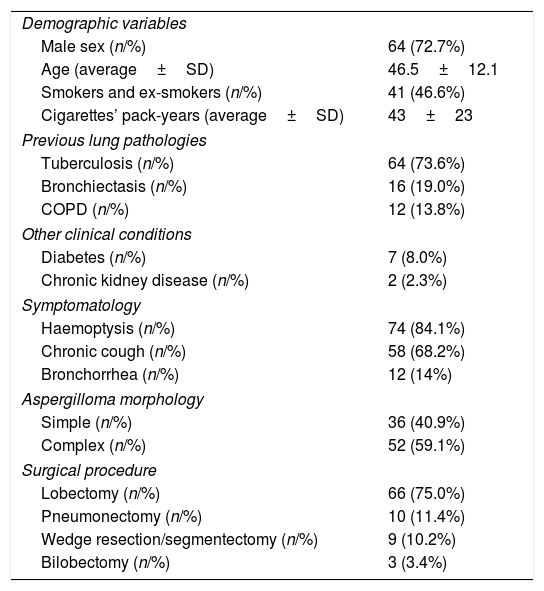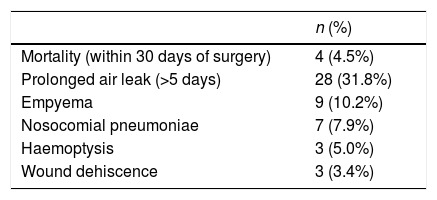Among the clinical syndromes caused by the fungus Aspergillus spp., aspergillomas are the most common form of pulmonary involvement. This non-invasive form of aspergillosis consists of a fungus ball – formed by fungal hyphae, inflammatory cells and tissue debris – and usually develops in pre-existing lung cavities.1,2 Although aspergillomas resolve spontaneously in up to 10% of the patients, they tend to remain stable in most cases.1,2 They can present with haemoptysis or, less commonly, cough, dyspnoea and/or fever. However, there is no consensus on the best treatment approach: whereas medical management has yielded limited results, surgical removal seems to be the only long-term efficient treatment but is overshadowed by a relatively high rate of post-operative complications.1,2
This study consisted of a 26-years (January 1990–December 2015) retrospective assessment of pulmonary aspergilloma surgical interventions in a single centre in the north of Portugal (Centro Hospitalar de Vila Nova de Gaia/Espinho). A previous clinical series, encompassing 60 cases that occurred between 1990 and 2004, has been published.3 We updated and extended that series, focusing on surgery-related morbidity, mortality, follow-up and clinical relapses.
During the period considered, 88 patients were submitted to pulmonary aspergilloma surgical intervention: 72.7% of them were male, their average age was 46.5 years, and almost half of them (46.6%) were or had been smokers (Table 1). Tuberculosis was the most common underlying lung pathology, being present in 73.6% of the patients, whereas bronchiectasis and chronic obstructive pulmonary disease (COPD) were present in 19.0% and 13.6%, respectively. Seven patients (8.0%) had been diagnosed with diabetes and two patients suffered from chronic kidney disease. Aspergillomas were equally distributed by side (51.1% in the right lung and 48.9% in the left lung), and more commonly located in the upper lobes (78.0%). In respect to symptomatology, the majority of the patients presented haemoptysis (84.1% of all patients), whereas 68.2% and 14% presented with chronic cough and bronchorrhea, respectively (Table 1). Most patients (56.8%) had normal respiratory function.
Cohort characterization.
| Demographic variables | |
| Male sex (n/%) | 64 (72.7%) |
| Age (average±SD) | 46.5±12.1 |
| Smokers and ex-smokers (n/%) | 41 (46.6%) |
| Cigarettes’ pack-years (average±SD) | 43±23 |
| Previous lung pathologies | |
| Tuberculosis (n/%) | 64 (73.6%) |
| Bronchiectasis (n/%) | 16 (19.0%) |
| COPD (n/%) | 12 (13.8%) |
| Other clinical conditions | |
| Diabetes (n/%) | 7 (8.0%) |
| Chronic kidney disease (n/%) | 2 (2.3%) |
| Symptomatology | |
| Haemoptysis (n/%) | 74 (84.1%) |
| Chronic cough (n/%) | 58 (68.2%) |
| Bronchorrhea (n/%) | 12 (14%) |
| Aspergilloma morphology | |
| Simple (n/%) | 36 (40.9%) |
| Complex (n/%) | 52 (59.1%) |
| Surgical procedure | |
| Lobectomy (n/%) | 66 (75.0%) |
| Pneumonectomy (n/%) | 10 (11.4%) |
| Wedge resection/segmentectomy (n/%) | 9 (10.2%) |
| Bilobectomy (n/%) | 3 (3.4%) |
All surgeries were done under general anaesthesia and patients were intubated with a double-lumen endotracheal tube to allow selective lung ventilation. A posterolateral thoracotomy approach was employed, and the type of resection was selected in each case in order to minimize the resected tissue without compromising the disease elimination: a lobectomy was performed in most patients (75.0%), whereas a pneumonectomy, a wedge resection or a segmentectomy and a bilobectomy were performed in 11.4%, 10.2% and 3.4% of all patients, respectively (Table 1). The majority (59.1%) of the aspergillomas had a complex morphology, according to the definition of Belcher and Plummer.4 Six patients (6.8%) required a subsequent surgical intervention because of wound dehiscence (n=2), haemothorax (n=1), broncopleural fistula (n=2) and empyema (n=1).
Patients’ chest tubes were removed in median five days (interquartile range 7–17) after surgery, while patients’ discharge took place in median 11 days (interquartile range 4–11) after the intervention. Four patients (4.5%) died within 30 days of surgery, and 38 (43.1%) presented some type of post-surgical complication (Table 2). An air leak for a period more than 5 days was the most common complication, affecting 31.8% of the patients. Moreover, 10.2% patients presented with empyema, 7.9% developed a nosocomial pneumoniae, and 5.0% maintained haemoptysis. Patient follow-up lasted for nine months on average (±17) and the overall global mortality was 7%. Two patients had a contralateral relapse.
The incidence of post-operative morbidity increased more than 2.5-fold (16.3% in the 1990–2004 period to 42.9% in the 2005–2016 period). This may be related with the higher frequency of aspergillomas with a complex morphology: in fact, 64.0% of all aspergillomas between 2005 and 2016 were considered to be complex versus 56.7% between 1990 and 2004. A complex morphology is indeed a poor prognosis factor for aspergilloma surgical removal.5
There was a slight reduction in the mortality rate (5.0% in the 1990–2004 period and 3.6% in the 2005–2016 period). The post-operative mortality of aspergilloma patients is considered to be relatively high, with some series reporting up to 44%.5 However, contemporaneous series tend to present lower values, similar to the one reported here.
Overall, the clinical characteristics, symptomatology and outcomes of this case series, the largest one described in Portugal, overlap those previously published in the literature, and support an early surgical intervention as the most effective option for aspergilloma patients. In fact, taking into account that more than half of the patients with an aspergilloma will eventually develop haemoptysis, and up to 20% will have a fatal haemorrhage, the risks of surgery are largely justified.5 Moreover, aspergilloma surgical removal attenuates or eliminates the symptomatology, increasing patients’ quality of life and life expectation.
Authors’ contributionAna Luísa Vieira drafted the manuscript, Susana Laeiro and Pedro Fernandes supported data collection, Miguel Guerra conceived and designed the study and all authors revised the manuscript and approved its final version.
Conflicts of interestThe authors have no conflicts of interest to declare.
Ana Luísa Vieira would like to thank Catarina L. Santos for medical writing advice.









